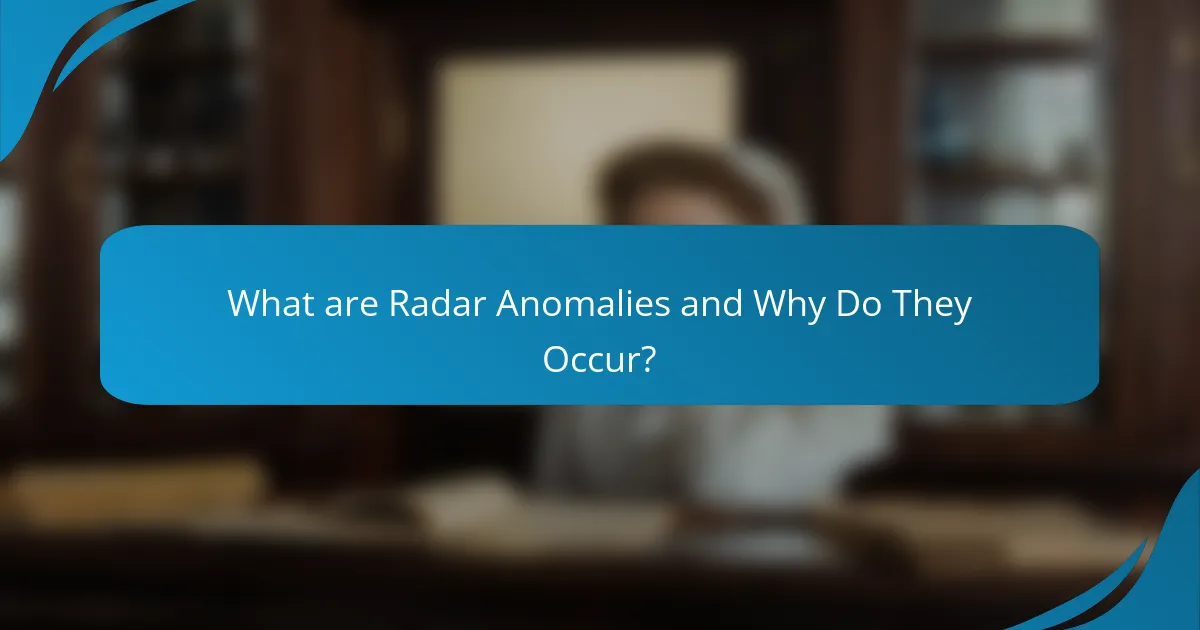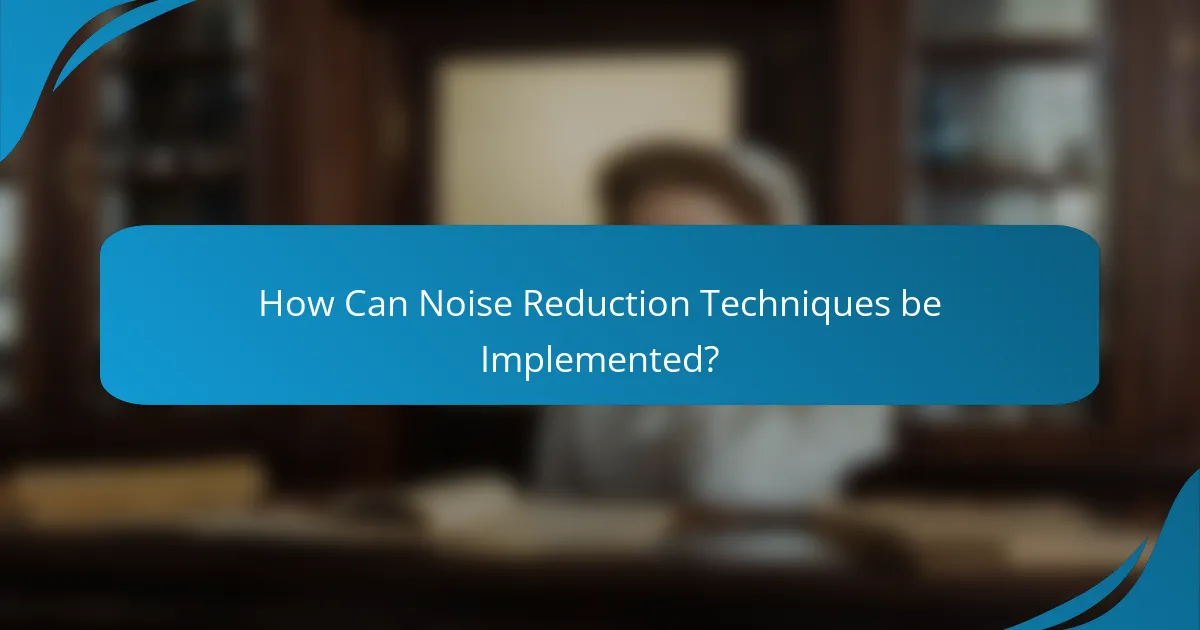Radar anomalies refer to unexpected deviations in radar data that can compromise detection accuracy. These anomalies arise from various factors, including environmental conditions, electronic interference, and equipment malfunctions. The article explores techniques for mitigating these anomalies, focusing on signal enhancement methods such as filtering, averaging, and adaptive processing, which improve detection accuracy in radar systems. Additionally, it discusses noise reduction strategies, including structural modifications and advanced signal processing techniques, that significantly enhance signal clarity and overall radar performance. Implementing these approaches is crucial for achieving reliable radar operations.

What are Radar Anomalies and Why Do They Occur?
Radar anomalies are unexpected deviations in radar data that can affect the accuracy of detection. These anomalies occur due to various factors such as environmental conditions, interference, and equipment malfunctions. For example, weather phenomena like rain, snow, or fog can scatter radar signals, leading to false readings. Additionally, electronic interference from other devices can create noise that masks genuine signals. Equipment issues, such as calibration errors or hardware failures, can also result in anomalies. Studies show that understanding these causes is essential for improving radar reliability and performance.
How do environmental factors contribute to radar anomalies?
Environmental factors contribute to radar anomalies by affecting signal propagation and reflection. Weather conditions such as rain, fog, and snow can attenuate radar signals. This attenuation leads to reduced detection range and accuracy. Temperature inversions can cause radar signals to bend, resulting in false targets. Terrain features, like mountains and buildings, can create shadowing effects that obscure actual objects. Additionally, atmospheric conditions can introduce clutter, which interferes with target identification. These factors collectively hinder radar performance and reliability.
What specific environmental conditions affect radar performance?
Radar performance is significantly affected by environmental conditions such as precipitation, temperature, humidity, and atmospheric pressure. Precipitation, including rain and snow, can attenuate radar signals, reducing detection range. Temperature inversions can cause radar signals to bend, leading to false targets. High humidity levels can increase the radar’s susceptibility to interference. Atmospheric pressure variations can impact the propagation of radar waves. These conditions can lead to anomalies in radar readings, affecting overall performance.
How do atmospheric phenomena lead to radar signal distortion?
Atmospheric phenomena lead to radar signal distortion through various mechanisms, including refraction, attenuation, and scattering. Refraction occurs when radar signals pass through layers of air with differing temperatures or humidity, bending the signals and altering their path. This can cause the radar to misinterpret the position of objects.
Attenuation happens when atmospheric conditions, such as rain or fog, absorb or weaken the radar signals. This results in reduced signal strength and clarity, making it difficult to detect targets accurately. Scattering occurs when radar signals encounter irregularities in the atmosphere, such as precipitation or turbulence. This can disperse the signals in multiple directions, leading to false returns or echoes.
Studies have shown that heavy precipitation can significantly increase signal loss, affecting radar accuracy. For example, the National Oceanic and Atmospheric Administration (NOAA) has documented cases where severe weather conditions caused up to a 50% reduction in radar effectiveness. These atmospheric effects are critical considerations for radar system design and operation.
What types of radar anomalies are commonly encountered?
Common types of radar anomalies include clutter, ghost targets, and multipath propagation. Clutter refers to unwanted echoes from objects such as buildings or trees. Ghost targets are false representations of objects that do not exist in reality. Multipath propagation occurs when radar signals reflect off surfaces and arrive at the receiver via multiple paths. These anomalies can degrade radar performance and accuracy. Understanding these types is crucial for effective radar operation and mitigation strategies.
How do false targets manifest in radar systems?
False targets in radar systems manifest as incorrect or misleading signals that appear to represent objects. These signals can arise from various sources, including noise, multipath propagation, and interference. Noise can create random fluctuations that radar interprets as targets. Multipath propagation occurs when radar signals reflect off surfaces, leading to multiple returns that confuse target identification. Interference from other electronic devices can also generate false echoes. Additionally, radar can misinterpret clutter, such as birds or weather phenomena, as targets. These manifestations complicate accurate target detection and tracking.
What are the differences between clutter and interference?
Clutter and interference are distinct concepts in radar systems. Clutter refers to unwanted echoes from objects in the environment, such as buildings or terrain. These echoes can mask the desired signal, complicating target detection. Interference, on the other hand, involves unwanted signals that disrupt the radar’s operation. This can stem from electronic devices or other radar systems. Clutter is typically stationary and predictable, while interference may vary and can be more random. Understanding these differences is crucial in developing effective techniques for mitigating radar anomalies.

What Techniques are Available for Signal Enhancement?
Techniques available for signal enhancement include filtering, averaging, and adaptive processing. Filtering removes unwanted noise from the signal. Averaging combines multiple signal samples to improve clarity. Adaptive processing adjusts techniques based on the signal’s characteristics. These methods are widely used in radar systems to improve detection accuracy. For instance, filtering techniques like Kalman filters can significantly enhance signal quality in noisy environments. Studies show that these techniques can improve signal-to-noise ratios by 20 dB or more.
How can adaptive filtering improve radar signal quality?
Adaptive filtering improves radar signal quality by dynamically adjusting filter parameters to minimize noise. This technique enhances the clarity of received signals. It effectively suppresses interference and enhances desired signal features. Adaptive filters can track changing signal characteristics in real-time. They utilize algorithms such as Least Mean Squares (LMS) or Recursive Least Squares (RLS). These algorithms adapt the filter coefficients based on incoming data. Studies show that adaptive filtering significantly reduces clutter in radar returns. For instance, research indicates a reduction in false alarm rates by up to 30% when using adaptive filtering techniques.
What are the principles behind adaptive filtering?
Adaptive filtering operates on the principle of adjusting filter parameters in real-time to optimize signal processing. This technique continuously updates its coefficients based on the input signal characteristics. The goal is to minimize the difference between the desired and actual output signals.
Adaptive filters use algorithms such as Least Mean Squares (LMS) and Recursive Least Squares (RLS) for this adjustment. These algorithms enable the filter to adapt to changing environments and signal conditions. The performance of adaptive filtering is often evaluated using metrics like Mean Squared Error (MSE).
Research indicates that adaptive filtering is effective in mitigating noise and enhancing signal quality in various applications, including radar systems. For instance, studies show that adaptive filters can significantly improve target detection rates in noisy environments.
How does adaptive filtering compare to traditional filtering methods?
Adaptive filtering dynamically adjusts its parameters based on incoming signals, while traditional filtering uses fixed parameters. This adaptability allows adaptive filters to effectively respond to varying noise conditions and signal characteristics. Traditional filters can struggle to maintain performance in changing environments. For instance, adaptive filters can improve signal-to-noise ratios by continuously optimizing their response. Research indicates that adaptive filters can outperform traditional methods in environments with non-stationary interference. Studies show that adaptive filtering techniques have been widely adopted in radar systems to mitigate anomalies and enhance signal clarity.
What role does digital signal processing play in radar enhancement?
Digital signal processing (DSP) significantly improves radar performance. It enhances the quality of radar signals by reducing noise and increasing detection accuracy. DSP techniques include filtering, signal averaging, and adaptive algorithms. These methods help to isolate relevant signals from background noise. For instance, clutter suppression techniques utilize DSP to enhance target detection in adverse conditions. Additionally, DSP allows for real-time processing, enabling immediate analysis and response. Studies show that implementing DSP can increase radar range and resolution. Therefore, DSP is crucial for modern radar systems in achieving optimal performance.
How do algorithms optimize radar signal interpretation?
Algorithms optimize radar signal interpretation by applying advanced mathematical techniques to enhance signal clarity and reduce noise. These algorithms analyze incoming radar data to identify patterns and extract meaningful information. Techniques such as adaptive filtering improve signal-to-noise ratios. Machine learning algorithms can classify targets and differentiate them from clutter. Real-time processing allows for immediate adjustments based on environmental changes. Statistical methods are employed to predict and mitigate anomalies in radar signals. Research indicates that these optimizations lead to improved detection rates and accuracy in various applications, including aviation and defense.
What are the latest advancements in digital signal processing for radar?
Recent advancements in digital signal processing (DSP) for radar include enhanced algorithms for target detection and tracking. These algorithms utilize machine learning to improve accuracy in complex environments. Adaptive filtering techniques have also been developed to reduce noise and enhance signal clarity. Furthermore, the integration of real-time processing capabilities allows for quicker response times in dynamic scenarios. Researchers have introduced advanced compression techniques to optimize data transmission without loss of critical information. Additionally, the use of synthetic aperture radar (SAR) has seen improvements in image resolution through refined signal processing methods. These advancements collectively contribute to more reliable radar systems in various applications.

How Can Noise Reduction Techniques be Implemented?
Noise reduction techniques can be implemented through various methods such as filtering, signal processing, and structural modifications. Filtering involves using algorithms to eliminate unwanted noise from radar signals. Signal processing techniques, like adaptive filtering, dynamically adjust to changing noise conditions. Structural modifications may include soundproofing or redesigning radar equipment to minimize noise interference. These methods have been proven effective in enhancing signal clarity and improving radar performance. Studies show that implementing these techniques can lead to a significant reduction in noise levels, thus enhancing detection accuracy.
What are the primary methods for reducing noise in radar systems?
The primary methods for reducing noise in radar systems include signal processing techniques, antenna design improvements, and the use of advanced filtering methods. Signal processing techniques such as adaptive filtering can effectively minimize noise by adjusting filter parameters in real-time. Antenna design improvements, like using higher gain antennas, can enhance signal-to-noise ratio by focusing energy more effectively. Advanced filtering methods, including Kalman filters and wavelet transforms, help separate signal from noise based on statistical properties. These methods are supported by research demonstrating their effectiveness in enhancing radar performance in various environments.
How does noise cancellation technology function in radar?
Noise cancellation technology in radar functions by filtering out unwanted signals. This process enhances the clarity and accuracy of the radar’s primary signals. It employs algorithms that analyze incoming data to distinguish between noise and relevant information. The technology often uses techniques such as adaptive filtering. Adaptive filtering adjusts the filter parameters in real-time based on the detected noise characteristics. This allows for effective noise suppression without significantly affecting the desired signal. Additionally, noise cancellation can involve spatial filtering methods. These methods utilize multiple antennas to create a more focused reception pattern. This approach further reduces noise by leveraging the spatial diversity of the radar signals. Overall, noise cancellation technology significantly improves radar performance in various environments.
What are the benefits of using hardware-based noise reduction?
Hardware-based noise reduction improves signal clarity in radar systems. It effectively minimizes unwanted noise during signal processing. This leads to enhanced target detection and tracking accuracy. Hardware solutions often operate in real-time, providing immediate results. They can reduce the computational load on software systems. This results in faster processing times and increased system efficiency. Additionally, hardware-based methods can be more reliable under varying environmental conditions. Studies show that systems using hardware noise reduction achieve higher signal-to-noise ratios.
What best practices should be followed for effective noise reduction?
Effective noise reduction can be achieved by implementing several best practices. First, use proper shielding to minimize electromagnetic interference. Second, maintain a clean power supply to reduce electrical noise. Third, optimize signal processing algorithms to filter out unwanted noise. Fourth, employ adaptive filtering techniques that adjust to changing noise environments. Fifth, regularly calibrate equipment to ensure accurate readings. Finally, consider physical placement of sensors to avoid noise sources. These practices enhance signal clarity and improve overall radar performance.
How can regular maintenance improve radar performance?
Regular maintenance can significantly improve radar performance by ensuring optimal functionality. This includes routine inspections, cleaning, and calibration of radar components. Regular checks help identify and rectify issues such as misalignment or wear. Proper cleaning removes debris that can obstruct signals. Calibration ensures accuracy in target detection and range measurements. According to studies, well-maintained radar systems show up to 30% improvement in signal clarity. Additionally, maintenance can extend the lifespan of radar equipment, reducing long-term costs. Overall, consistent upkeep leads to enhanced reliability and performance in radar operations.
What troubleshooting steps can be taken to identify noise sources?
To identify noise sources, start by isolating the radar system from external influences. Conduct a visual inspection of the equipment for loose connections or damaged components. Utilize spectrum analyzers to measure frequency ranges and identify unexpected signals. Perform a systematic check of environmental factors, such as nearby electronic devices that may interfere. Use shielding techniques to minimize external noise and assess the radar performance in different operational environments. Document findings and compare with baseline performance metrics to pinpoint anomalies. These steps enhance the ability to accurately diagnose and mitigate noise sources affecting radar systems.
What practical tips can enhance radar signal integrity?
To enhance radar signal integrity, implement signal processing techniques such as filtering and averaging. Filtering removes unwanted noise and enhances the desired signal. Averaging multiple radar returns helps to mitigate random noise and improve clarity. Additionally, optimizing antenna design can significantly improve signal reception. A well-designed antenna focuses energy more effectively, reducing interference. Regular maintenance of radar equipment ensures optimal performance by addressing wear and tear. Calibration of radar systems is crucial to maintain accuracy and reliability. Employing advanced algorithms for target detection enhances the interpretation of radar signals. These methods collectively contribute to improved radar signal integrity.
Mitigating Radar Anomalies focuses on enhancing radar signal quality through various techniques aimed at reducing noise and improving detection accuracy. The article explores the causes of radar anomalies, including environmental factors and equipment issues, and discusses common types such as clutter and false targets. It outlines advanced methods for signal enhancement, including adaptive filtering and digital signal processing, while also emphasizing best practices for noise reduction and regular maintenance. The content provides a comprehensive overview of strategies to optimize radar performance and reliability in diverse operational environments.